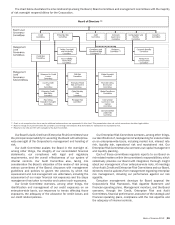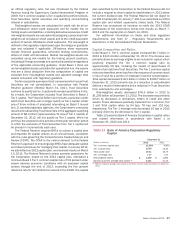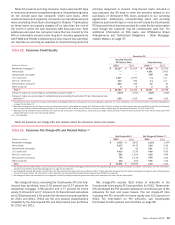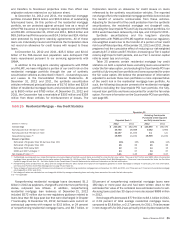Bank of America 2012 Annual Report Download - page 77
Download and view the complete annual report
Please find page 77 of the 2012 Bank of America annual report below. You can navigate through the pages in the report by either clicking on the pages listed below, or by using the keyword search tool below to find specific information within the annual report.Bank of America 2012 75
Also, if the rating agencies had downgraded their long-term
senior debt ratings for the Corporation or certain subsidiaries by
one incremental notch, the derivative liability that would be subject
to unilateral termination by counterparties as of December 31,
2012 was $3.8 billion, against which $3.0 billion of collateral has
been posted. If the rating agencies had downgraded their long-
term senior debt ratings for the Corporation and certain
subsidiaries by a second incremental notch, the derivative liability
that would be subject to unilateral termination by counterparties
as of December 31, 2012 was an incremental $1.7 billion, against
which $1.1 billion of collateral has been posted.
While certain potential impacts are contractual and
quantifiable, the full scope of consequences of a credit ratings
downgrade to a financial institution is inherently uncertain, as it
depends upon numerous dynamic, complex and inter-related
factors and assumptions, including whether any downgrade of a
firm’s long-term credit ratings precipitates downgrades to its short-
term credit ratings, and assumptions about the potential behaviors
of various customers, investors and counterparties. For additional
information on potential impacts of credit rating downgrades, see
Time to Required Funding and Stress Modeling on page 72.
For information regarding the additional collateral and
termination payments that could be required in connection with
certain OTC derivative contracts and other trading agreements as
a result of such a credit rating downgrade, see Item 1A. Risk
Factors of this Annual Report on Form 10-K.
On June 8, 2012, S&P affirmed its AA+ long-term and A-1+
short-term sovereign credit rating on the U.S. government. The
outlook remains negative. On July 10, 2012, Fitch affirmed its AAA
long-term and F1+ short-term sovereign credit rating on the U.S.
government. The outlook remains negative. Moody’s also rates
the U.S. government AAA with a negative outlook. All three rating
agencies have indicated that they will continue to assess fiscal
projections and consolidation measures, as well as the medium-
term economic outlook for the U.S.
Credit Risk Management
Credit quality improved during 2012 due in part to improving
economic conditions. Our proactive credit risk management
initiatives positively impacted the credit portfolio as charge-offs
and delinquencies continued to improve across most portfolios
and risk ratings improved in the commercial portfolios. For more
information, see Executive Summary – 2012 Economic and
Business Environment on page 22.
Credit risk is the risk of loss arising from the inability or failure
of a borrower or counterparty to meet its obligations. Credit risk
can also arise from operational failures that result in an erroneous
advance, commitment or investment of funds. We define the credit
exposure to a borrower or counterparty as the loss potential arising
from all product classifications including loans and leases, deposit
overdrafts, derivatives, assets held-for-sale and unfunded lending
commitments which include loan commitments, letters of credit
and financial guarantees. Derivative positions are recorded at fair
value and assets held-for-sale are recorded at either fair value or
the lower of cost or fair value. Certain loans and unfunded
commitments are accounted for under the fair value option. Credit
risk for these categories of assets is not accounted for as part of
the allowance for credit losses but as part of the fair value
adjustments recorded in earnings. For derivative positions, our
credit risk is measured as the net cost in the event the
counterparties with contracts in which we are in a gain position
fail to perform under the terms of those contracts. We use the
current mark-to-market value to represent credit exposure without
giving consideration to future mark-to-market changes. The credit
risk amounts take into consideration the effects of legally
enforceable master netting agreements and cash collateral. Our
consumer and commercial credit extension and review procedures
take into account funded and unfunded credit exposures. For
additional information on derivative and credit extension
commitments, see Note 3 – Derivatives and Note 13 –
Commitments and Contingencies to the Consolidated Financial
Statements.
We manage credit risk based on the risk profile of the borrower
or counterparty, repayment sources, the nature of underlying
collateral, and other support given current events, conditions and
expectations. We classify our portfolios as either consumer or
commercial and monitor credit risk in each as discussed below.
We proactively refine our underwriting and credit management
practices as well as credit standards to meet the changing
economic environment. To actively mitigate losses and enhance
customer support in our consumer businesses, we have in place
collection programs and loan modification and customer
assistance infrastructures. We utilize a number of actions to
mitigate losses in the commercial businesses including increasing
the frequency and intensity of portfolio monitoring, hedging activity
and our practice of transferring management of deteriorating
commercial exposures to independent special asset officers as
credits enter criticized categories.
In January 2013, in connection with the FNMA Settlement, we
repurchased for $6.6 billion certain residential mortgage loans
that had previously been sold to FNMA, which we have valued at
less than the purchase price. The majority of these repurchased
loans will be included in our PCI portfolio. For additional information
on the FNMA Settlement, see Off-Balance Sheet Arrangements
and Contractual Obligations – Representations and Warranties on
page 50 and Note 8 – Representations and Warranties Obligations
and Corporate Guarantees to the Consolidated Financial
Statements.
During 2012, new regulatory guidance issued regarding the
treatment of loans discharged in Chapter 7 bankruptcy and
regulatory interagency guidance issued on junior-lien consumer
real estate loans adversely impacted the consumer portfolio’s
nonperforming loan and net charge-off statistics. In addition, the
National Mortgage Settlement adversely impacted net charge-offs
but resulted in a corresponding reduction in nonperforming loans.
For more information, see Consumer Portfolio Credit Risk
Management on page 76 and Table 21.
Certain European countries, including Greece, Ireland, Italy,
Portugal and Spain, have experienced varying degrees of financial
stress in recent years. For additional information on our exposures
and related risks in non-U.S. countries, see Non-U.S. Portfolio on
page 101 and Item 1A. Risk Factors of this Annual Report on form
10-K.
For information on our Credit Risk Management activities, see
Consumer Portfolio Credit Risk Management on page 76,
Commercial Portfolio Credit Risk Management on page 91, Non-
U.S. Portfolio on page 101, Provision for Credit Losses and
Allowance for Credit Losses both on page 105, Note 1 – Summary
of Significant Accounting Principles and Note 5 – Outstanding Loans
and Leases to the Consolidated Financial Statements.
























